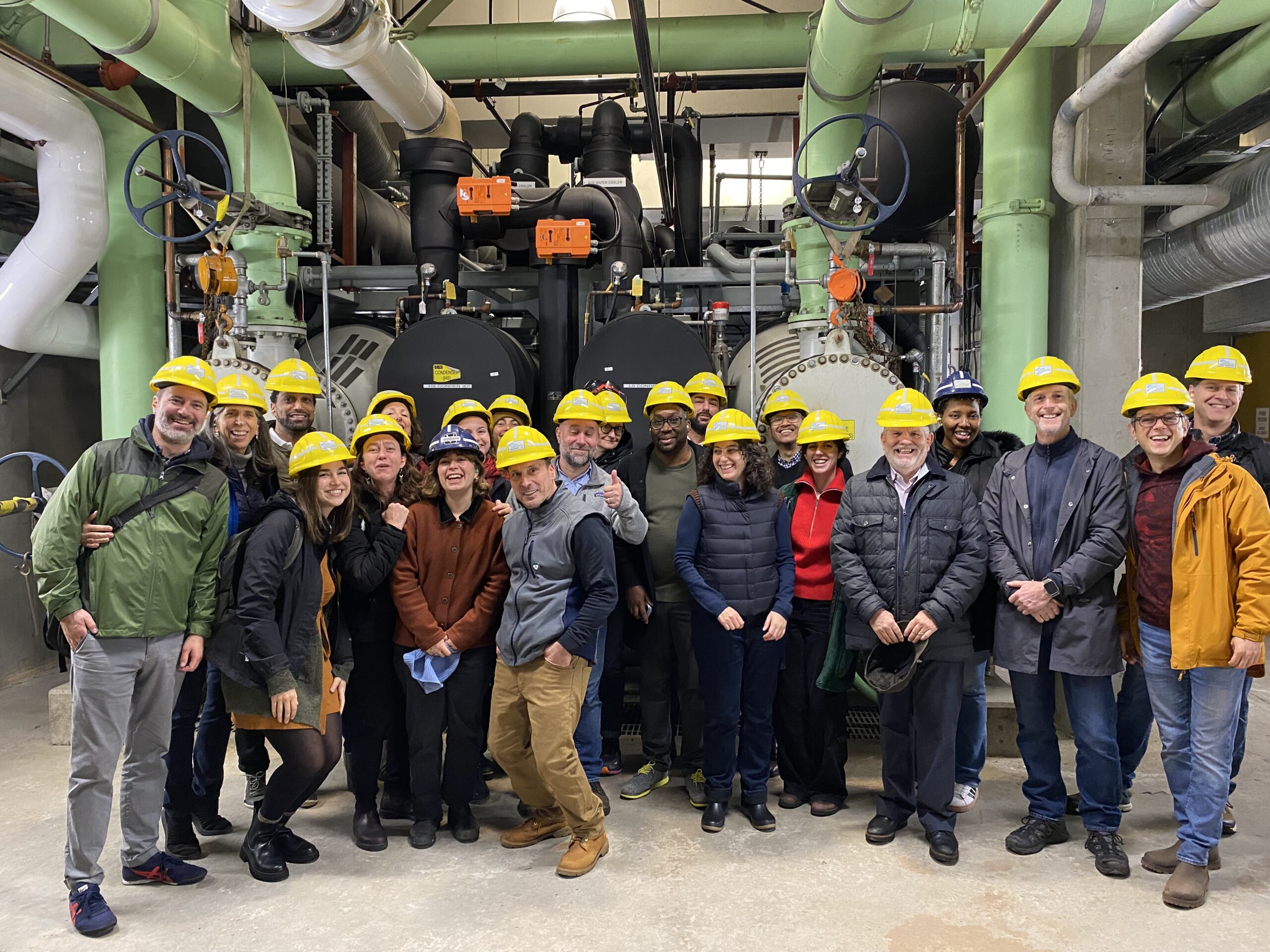
Our goal is a neighborhood-scale transformation of our buildings to clean, reliable, affordable energy. Thermal energy networks (TENs) may help accomplish this in many places. By installing TENs in the places where they bring the most benefit, we can reduce grid strain, safely replace leak-prone methane gas pipelines, and equitably deliver clean, modern technology to more neighborhoods.
Read on to explore the most frequently asked questions about TENs. If your question isn’t here, submit your own!
Our goal is a neighborhood-scale transformation of our buildings to clean, reliable, affordable energy. Thermal energy networks (TENs) may help accomplish this in many places. By installing TENs in the places where they bring the most benefit, we can reduce grid strain, safely replace leak-prone methane gas pipelines, and equitably deliver clean, modern technology to more neighborhoods.
Read on to explore the most frequently asked questions about TENs. If your question isn’t here, submit your own!
-
Thermal energy networks (TENs) provide efficient, non-combusting heating and cooling to entire neighborhoods.
TENs access ambient-temperature heat from local thermal energy sources. Some TENs use shallow boreholes to access thermal energy within the earth (see “What are geothermal networks?,” below), while others trade thermal energy between buildings, wastewater systems, or sources of waste heat, like data centers and industrial processes.
A loop of water-filled pipes efficiently moves this thermal energy, delivering it to geothermal heat pumps that heat and cool every building on the loop.

Here, the thermal energy resource is the earth, accessed through shallow boreholes. A pipe loop (in purple) connects to geothermal heat pumps (purple, on the sides of buildings) to heat and cool.
-
No. Thermal energy networks (TENs) are a proven technology that already function in more than 20 states and in multiple countries. Our Neighborhood-Scale Building Decarbonization Map locates TENs and geothermal energy networks (GENs) in North America and will soon expand to include other countries. You may suggest changes or new sites using this form.
-
Just as no two neighborhoods are the same, there’s not a one-size-fits-all approach to neighborhood-scale decarbonization. But BDC proposes two primary pathways to achieve it.
First, the electric network: Buildings stop using gas and rely on their area’s electric grid. At the building level, this involves replacing gas appliances with electric ones. At the grid level, this reduces emissions as states and utilities increasingly adopt clean and renewable energy sources to power the grid.
Second, the thermal energy network (TEN): Buildings achieve combustion-free heating and cooling by capturing, storing, and recycling heat through underground water-filled pipes, connected to buildings via geothermal heat pumps (GHPs). TENs come in different configurations. Some use shallow boreholes to take advantage of the earth’s temperature below ground, while others exchange heat from sources like wastewater or building cooling systems. The “network” aspect is key—the more buildings that connect to the system, the more efficient it becomes.
Choosing the pathway requires thinking across technical, social, and political domains. On the technical side, planners, utilities and engineers must consider upfront and operational costs, a neighborhood’s building density or proximity to heat sources, and potential hazards to the system. On the social and political sides, the right pathway requires meaningful community participation and enthusiasm, public engagement, market readiness, and political support.
-
The technology can function anywhere, but thermal energy networks (TENs) tend to make the most economic sense in places where:
- There is relatively high seasonal temperature variation (i.e., the climate experiences colder winters and/or hot summers).
- The neighborhoods are high-density, and buildings are relatively close together.
- There is “thermal load diversity,” meaning some buildings are heating-dominant while others are cooling-dominant, or buildings use heating and cooling at different times of the day.
- There is a source of untapped waste heat nearby (such as heat emitted from a data center).
These characteristics can reduce the costs of installation and help make systems more affordable for users. To learn more, scroll to “How can my community, campus, or neighborhood manage the costs of TENs installation?”
-
Geothermal energy networks (GENs), also known as networked geothermal, are thermal energy networks that use the earth’s stable, constant temperature as a thermal energy source. GENs circulate this energy via a single pipe loop in the street, similar to how gas pipelines work.
It works like this: Shallow boreholes are drilled into the ground, where they constantly absorb the earth’s mild temperature. Water-filled, U-shaped pipes are inserted into the boreholes and equalize with the temperature of the earth, then share that thermal energy with buildings above.
Geothermal networks have several key advantages. First, access to the abundant thermal energy underground can balance uneven thermal loads in buildings above ground. Second, the earth’s geological characteristics function as a battery, storing unneeded thermal energy for weeks or even months with very little heat dissipation.
-
Adapted from HEET’s Gas-to-Geo wiki.
Geothermal power plants: Geothermal power plants typically rely on very deep boreholes to access ultra-hot temperatures that can generate electricity. Thermal energy networks and geothermal energy networks do not generate electricity; instead, they are used for heating and cooling. They only absorb the ambient, mild temperature of the earth at relatively shallow depths (often less than 1,000 feet).
Geothermal district energy: These systems typically sit atop natural geothermal reservoirs with hot water close to the earth’s surface, which are unevenly distributed across the globe. A shared loop of pipes channel hot water into building heating systems, and typically do not provide cooling. (Despite their differences, these systems can still share many characteristics, like financing and ownership models, with thermal energy networks.)
Single-building geothermal: Geothermal, or ground-source, heat pumps are common heating and cooling solutions for single buildings. Thermal energy networks take this concept and increase its efficiency by linking the geothermal heat pumps in multiple buildings.
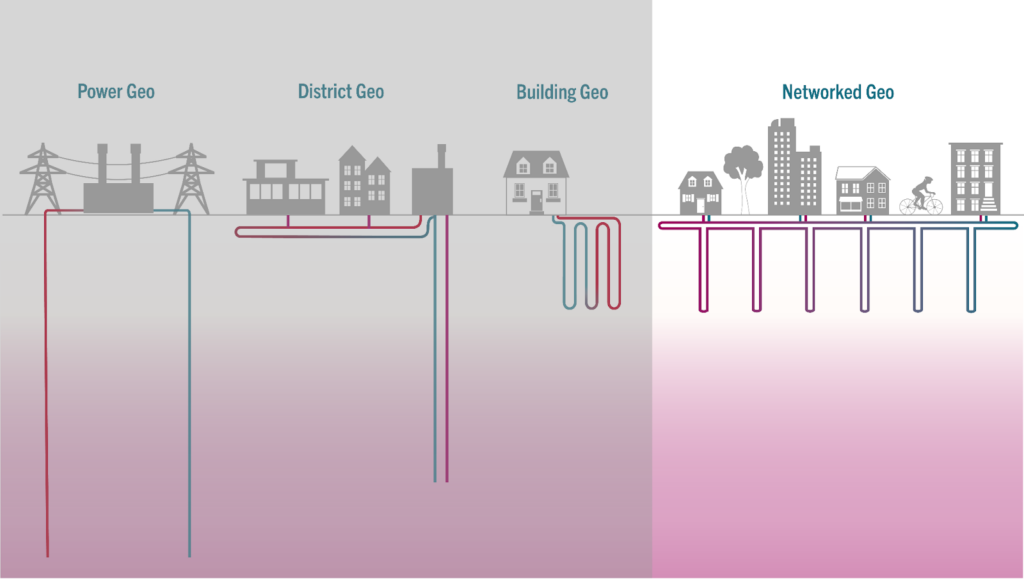
On the left, in gray: what thermal energy networks aren’t. Image copyright: HEET Gas-to-Geo
HEET has created many resources specific to geothermal networks, including a 3-page description of system components and a 5-page FAQ.
-
All thermal energy networks include a pipe loop system installed below the frostline. This is the main artery that circulates ambient-temperature water through the network.
Geothermal networks (GENs) include boreholes, several hundred feet deep, which connect to the ground loop. These boreholes act as a thermal “battery” that holds heat within the earth with minimal dissipation. Systems without boreholes may still need a thermal reservoir to store heat: this could be a lake, a river, or a water tank.
A circulating pump, powered by electricity, moves the water through the pipes. Sensors monitor the water temperature. A control panel keeps the water between approximately 40–90 ̊ Fahrenheit (the range in which ground-source heat pumps operate most efficiently).
Individual buildings are equipped with geothermal heat pumps, which are connected to the loop.
-
A thermal energy network’s (TEN) pipes are filled with water, or water with treatments to keep the temperature and materials stable. For example, propylene glycol—a food-safe additive that’s also found in cosmetics—has been added to some systems, like the geothermal network in Framingham, Massachusetts, as an antifreeze. Systems can avoid the need for glycol by keeping pipes snug underground beneath the frostline; this is the case at Colorado Mesa University.
-
A key to TENs’ and GENs’ efficiency is the “ambient temperature” liquid inside the pipes. The underground temperature is consistently a mild ~55°F in most parts of the country. The water flowing through the pipes equalizes its temperature to match the ambient temperature of the ground. By the time this mildly-warmed water reaches a building’s geothermal heat pump, minimal electricity is needed to raise or lower its temperature. This addresses two efficiency challenges simultaneously: it means geothermal networks can maintain high efficiency across seasons, and it reduces demand on the electric grid during peak periods.
-
Pipes for thermal energy networks (TENs) are typically built from high-density polyethylene, or HDPE. This material provides good thermal conductivity. It’s also the same type of pipe used for many gas lines, so gas workers are experts in it!
When these pipes are inserted into boreholes, they touch the surrounding soil or bedrock, and the water in the pipes equalizes with that surrounding temperature—it adjusts its thermal energy. The water then circulates this ambient-temperature thermal energy toward the geothermal heat pumps. In winter, those appliances absorb that energy and release it into a building in the form of heat. In summer, the process acts in reverse: geothermal heat pumps absorb thermal energy inside the building and transfer it into the water-filled pipes to circulate back into the earth, where, once again, the water will adjust its thermal energy to match the earth’s mild temperature. And on it goes!
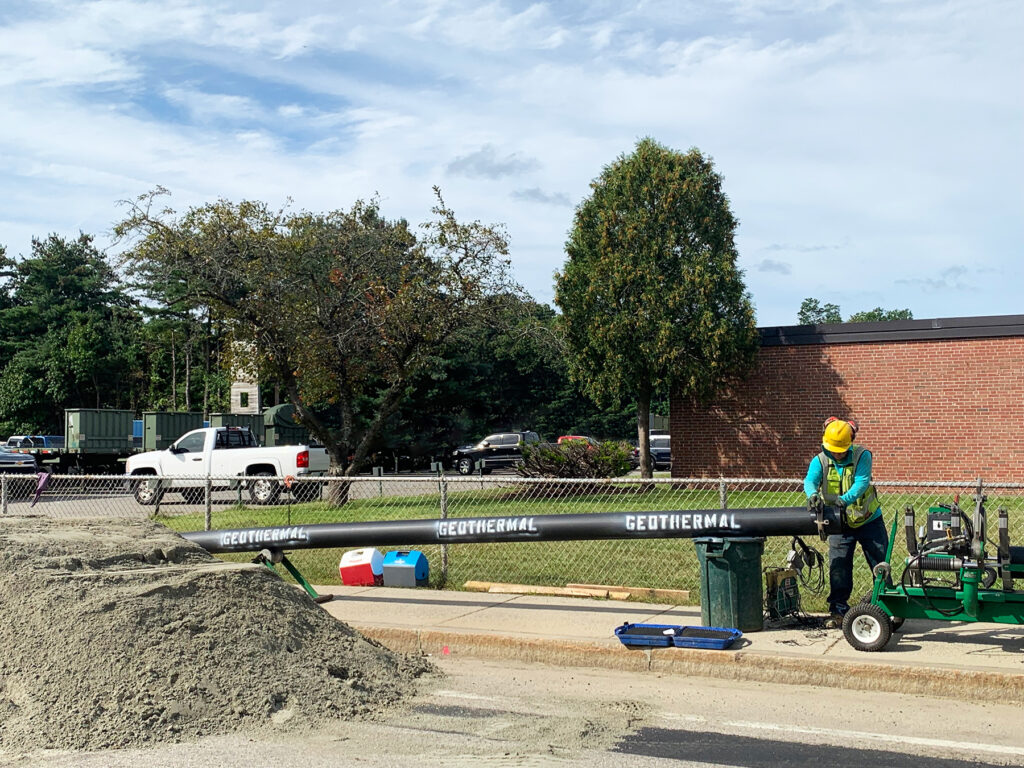
-
The upfront costs of a TEN can vary greatly. However, many community, campus, and municipal TENs, along with utility TENs pilots, are demonstrating ways to reduce these costs through thoughtful planning and design.
Costs usually derive from four main areas: siting, buildings, thermal resources, and pipe loop infrastructure. (Many of the bullets below are adapted from HEET’s “Site & Design Considerations” checklist).
Several aspects of the site selection can influence the cost of a project:
- Take advantage of favorable geology, such as shallow bedrock, to reduce drilling costs. The ground’s thermal conductivity data should be sent to all potential contractors during a Request for Proposals stage to receive the most accurate cost estimates.
- Groundwater quality and flow can affect thermal storage and the materials, like grout, used in a system.
- Pre-existing subsurface contamination may require cleanup.
- Implementing a TEN on a street with planned repaving or underground work can help distribute project costs.
- Similarly, an area with leak-prone gas pipe can avoid the cost of installing new gas pipe by installing geothermal pipes instead.
- Wetlands, coastal and river areas, and other areas that are ecologically or environmentally sensitive may require additional permitting and oversight.
Building characteristics can affect installation complexity and cost:
- TENs should take advantage of economies of scale. Serving more buildings and customers leads to greater efficiency and lower shared costs per building.
- Older buildings with deferred maintenance may require retrofits and energy efficiency improvements; this is not unique to TENs. While some TEN owners have covered the costs of all building retrofits to entice buildings to join a system, other system owners leave retrofits up to the individual building owners, which reduces costs but raises the barrier to join the TEN.
- Buildings should have adequate electric panel capacity and legal wiring.
- Some existing heating systems are easier to convert than others. Steam heat systems, for example, would need to be replaced.
The type and availability of thermal resources are also influential:
- More boreholes generally mean higher costs.
- The availability of drillers and drilling equipment can affect costs and timelines.
- In some cases, inexpensive thermal resources—such as nearby lakes, wastewater facilities, or waste heat generated by buildings and industrial processes—can reduce the number of boreholes and lower costs.
Careful design and strategic choices can reduce distribution (pipe loop) costs:
- A small, simply-designed pump house is cost-effective.
- Instead of overbuilding your system for rare, extreme weather events, consider a temporary electric boiler or chiller to handle infrequent conditions.
- Reducing the percentage of glycol, a food-safe antifreeze, helps control material costs.
-
Geothermal energy is abundant and practically limitless. Compared to gas, propane, and other fuels, thermal energy has a huge reliability advantage: it is local and does not need to travel hundreds of miles from a production well to a user, reducing the risk of leaks and pipeline failures.
Geothermal heat pumps run on electricity. Some thermal energy networks are designed with backup power (e.g., solar and/or batteries) to protect users in the event of electricity outages.
-
Geothermal and TENs represent an abundant, non-intermittent, local energy category that strengthens energy security. Geothermal energy operates 24/7/365, and TENs are quite literally rooted in the community by tapping local soil or heat sources—protecting customers and users from the volatility of international fuel markets.
-
TENs and GENs are the most efficient heating and cooling systems that we know of! Geothermal heat pumps alone are highly efficient appliances, but their efficiency grows when they are networked into a system. That is because a well-balanced network will reduce waste by trading thermal energy with other buildings. Buildings that currently offload heat as a waste byproduct, like grocery stores, food or water processing plants, industrial factories, data centers, or ice rinks, will instead send that heat to buildings that need it.
Geothermal networks, in particular, have an efficient storage solution in the form of boreholes. They are able to transfer excess heat from the pipe loop into the bedrock, where very little heat dissipates. The rest is stored and can be accessed weeks or months later.
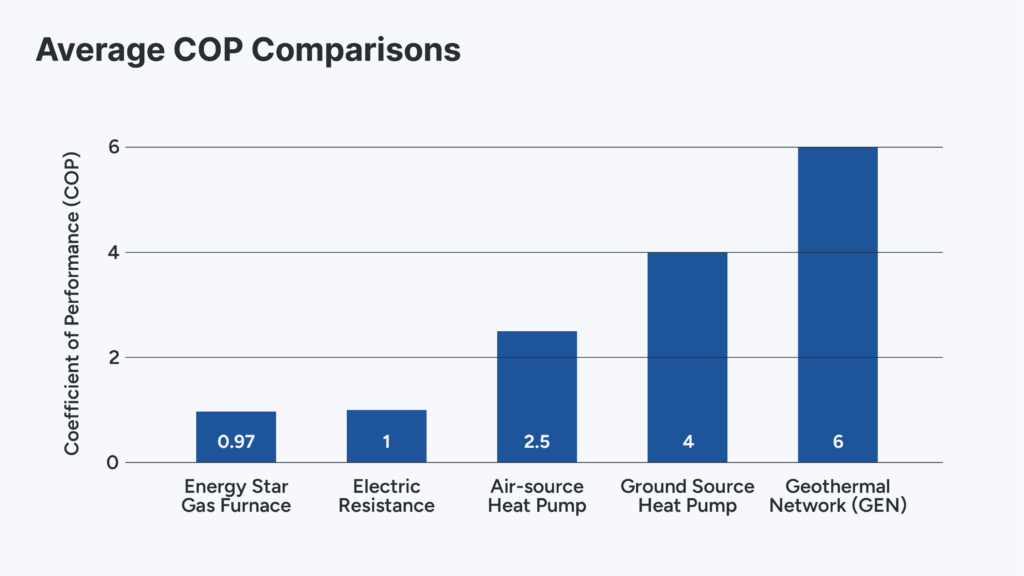
Geothermal networks have a coefficient of performance (COP) of 6 on average, meaning they generate 6 units of heat energy for every one unit of electric energy needed to run them. See how this compares to other heating and cooling solutions above.
All of this means that TENs and GENs draw much less power from the grid than other systems. This is crucial, because as the U.S. transitions off of fossil fuels, we will place ever-greater demand on our grid—especially during peak heating and cooling months. Thermal energy networks flatten the demand for electricity in those peak months and can help cancel the need to build thousands of additional miles of electric transmission lines.
-
Large commercial buildings can be “thirsty:” many conventional cooling systems rely on chillers and cooling towers that use water to evaporate heat. One estimate suggests that 5-15 billion gallons of fresh water are consumed daily to cool U.S. commercial spaces.
TENs use heat pumps that do not cool through evaporation. Instead, they move thermal energy through a compressor to remove heat, exactly like a refrigerator. By redistributing thermal energy instead of rejecting it as waste, TENs can replace some or all of a campus or building’s cooling towers.
To read real-world data on TENs and water savings, check out our brief, “Building Decarbonization Meets Water Conservation,” or watch the associated webinar recording accompanied by slides and a summary.

-
More than almost any other institution, regulated investor-owned utilities have the power and responsibility to put efficient and affordable energy into the hands of the customers that depend on them. TENs provide a viable option for utilities to continue delivering an essential service, keep their workforce employed in high-road jobs, and reduce emissions and pollution in the communities that they serve.
Utilities also have resources including capital financing access, an existing customer base, administrative expertise, the ability to safely decommission gas pipelines, and legal rights-of-way to install infrastructure. In some cases, this may mean that a utility-led TENs installation eases the daunting process of neighborhood-scale decarbonization.
For this reason, several U.S. states have passed legislation requiring or allowing regulated utilities to implement TENs pilot projects within their service territories. While TENs are a proven technology, these pilot projects aim to prove that TENs are a viable business model for utilities and an affordable option for customers—especially if a TEN can avoid the high cost of replacing aging or leak-prone gas pipelines. The pilots will collect data on billing and costs, utility service and maintenance, emissions reduction and job creation, and more. You can read more about recommended guidance for pilot legislation, including the importance of affordability, customer protection, and equity provisions, here.
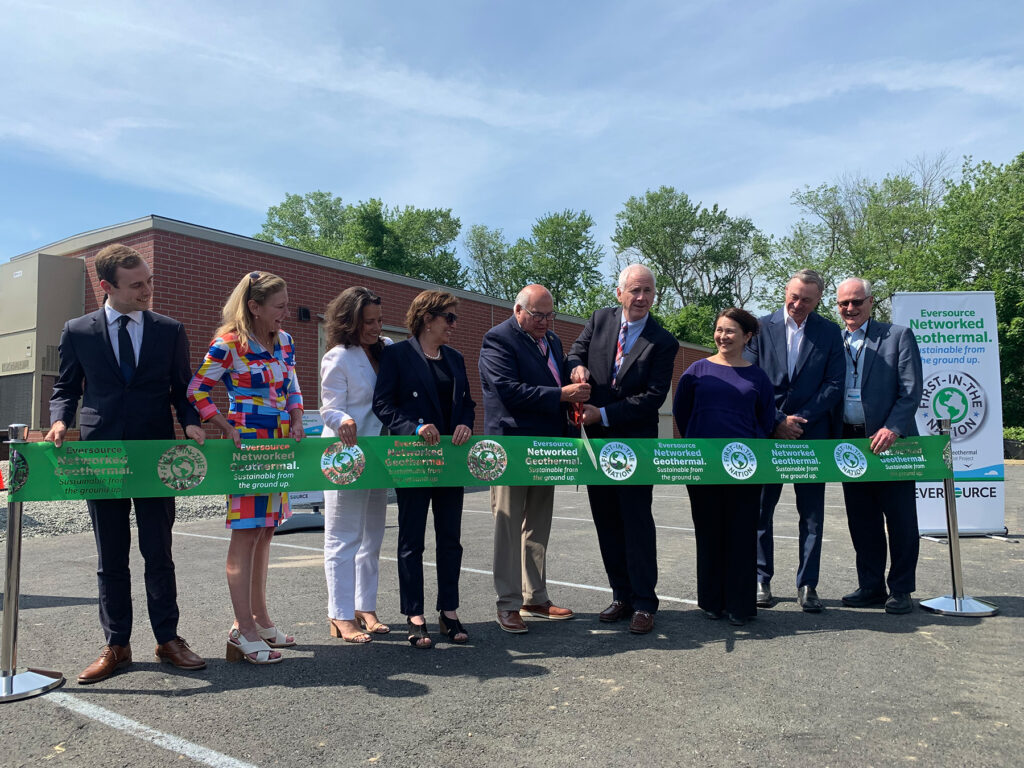
-
Yes! In fact, most operational TENs and geothermal district energy systems are actually owned by universities, private developers, municipalities, or communities.
A team of local leaders, advocates, and clean energy experts affiliated with Vermont Community Thermal Networks created an excellent toolkit that explores owning and operating TENs in municipal and community contexts. “How to Develop A Thermal Energy Network” specifies three additional ownership pathways, each with its own advantages and challenges:
- Municipal ownership, similar to a municipal water or sewer department which provides public services on behalf of a town or city.
- Cooperative ownership, which introduces shared control of a business entity and shares any profits resulting from the TEN among co-op membership.
- Third-party ownership, typically constructed by private organizations that are either for-profit or nonprofit and specialize in developing and managing infrastructure.
Any entity looking to construct a thermal energy network should consider not only ownership but business models, including for-profit, low-profit, or nonprofit; state or federal tax credits or funding opportunities for financing the project; and who will take on the responsibility of operation and maintenance.
-
Existing thermal energy networks (TENs) have proven long-term affordability. Single-owner TENs, like those on college campuses, have paid back the initial investment in just over a decade—for example, Colorado Mesa University’s geothermal network cost approximately $20 million to construct, but saves $1.5-$1.6 million a year in overall energy costs, equaling system payback in just over 12 years. It is so cost-effective that it has suppressed tuition hikes.
With more than 20 utility TENs pilots in the works, the systems’ financial performance will reveal how utility thermal energy networks (UTENs) impact customers’ heating and cooling bills. For the duration of the pilot, participating customers should not pay more for their total energy bills than they currently do. Utility pilots in Massachusetts and New York have therefore set bill caps to protect the residents participating in the pilot programs.
Utility-scale, municipal, or community-owned TENs may lower a building’s energy bills for individual consumers for four main reasons:
- Customers will no longer pay the delivered cost of heating oil, natural gas, or propane for heating.
- By using locally-sourced heat that is not subject to commodity market volatility, customers are protected from price fluctuations.
- The efficiency of a TEN reduces the electricity a household uses for heating and cooling. Eversource Energy’s utility pilot in Framingham, Massachusetts, is predicted to reduce annual bills for participating customers, particularly in buildings where residents previously heated with less-efficient electric resistance heat.
- TENs can directly reduce costs by “flattening the curve” of electricity demand, and by extension, reducing the need for new transmission and distribution infrastructure. The Department of Energy found that widespread installation of geothermal heat pumps could avoid the need for ~24,500 miles of new transmission lines by 2050. This avoided buildout is projected to save $557 billion nationwide, which would otherwise be billed to ratepayers.
Upfront installation costs for TENs are high compared to other systems, such as decarbonizing with air-source heat pumps. However, once installed, the annual operating costs are generally lower. Below is a graph adapted from a financial analysis for a housing authority in Connecticut that compared a GEN to air-source heat pumps.
Geothermal energy network (GEN)
Air-source heat pumps (ASHPs)
Net Capital Cost
$4.7 million (IRA and utility tax credits deducted)
$4.3 million (not eligible for tax credits)
Lifecycle Cost (30 years)
$8.6 million
$21.5 million
Annual operations costs
$156,942
$304,700
The annual operating costs for air-source heat pumps (ASHPs) were nearly double the operating costs of the TEN, and the 30-year lifecycle cost was nearly triple the cost of the TEN.
-
There are a multitude of approaches and technologies to decarbonize buildings. We need to use them all: from reducing energy consumption, to monitoring electricity usage with smart meters, to installing efficient appliances in homes and offices. In low-density or rural areas, an air-source heat pump (ASHP) or geothermal heat pump may make sense for individual homeowners or entire neighborhoods. These individual systems can also be advantageous if a building owner is eager to decarbonize quickly, and has the financial means to move forward on a short timeline without waiting for a community, municipal, or utility-scale approach.
Wise use of thermal energy networks (TENs), in the places where they are most feasible, strategic, and deliver the greatest benefits, means more people gain neighborhood-scale access to modern technologies and cleaner air, and we spend less time and money upgrading the grid.
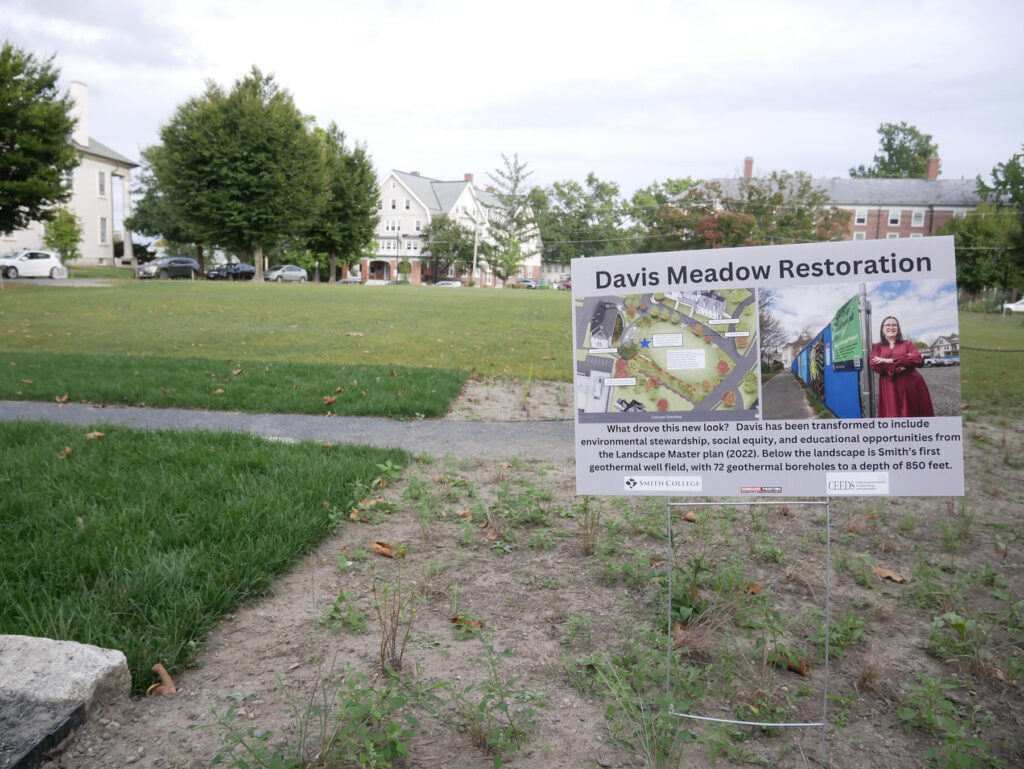
Smith College, in Northampton, Massachusetts, drilled 72 geothermal boreholes that now work invisibly and quietly beneath a campus meadow.
-
There’s a reason that John Murphy, international representative for the New York State Pipe Trades Association, said of TENs: “This is the closest thing to a true transition or just transition that we’ve seen in the energy transformation so far.” Installing these networks requires the knowledge and skills of pipeline and utility workers, the same workforce that traditionally installed gas systems. In a review of low-carbon job opportunities for oil and gas workers in Pennsylvania, researchers found that the geothermal industry was the “best fit” for these workers, who are already equipped with knowledge of geoscience, reservoir engineering, drilling, and surface production and facilities management.
On a tour of TENs in Vancouver, Ed Nadeau, Business Manager and Financial Secretary for New York’s UA Local 7, agreed: “Geothermal will mean we need more workers,” he said. “We’ll go out there and recruit new apprentices and they will go on to have careers with a pension, health insurance, and a good professional living.”
Many workers are justifiably concerned about piecemeal decarbonization approaches, which risk reducing wages and displacing family-sustaining careers. TENs are one solution that can provide scale for both consumers and workers. As a result, many labor unions and workers’ organizations support TENs legislation with labor provisions. You may read more about legislation and fair labor provisions in our Legislative Guidebook, or watch Cornell University’s informative webinar: Understanding Thermal Energy Networks: A Building Decarbonization Approach to Good Union Jobs.
Related: Curious about the skills involved in drilling geothermal boreholes? This three-minute video from Brightcore Energy shows the technical expertise needed to retrofit a historical building in New York City with geothermal heat pumps.
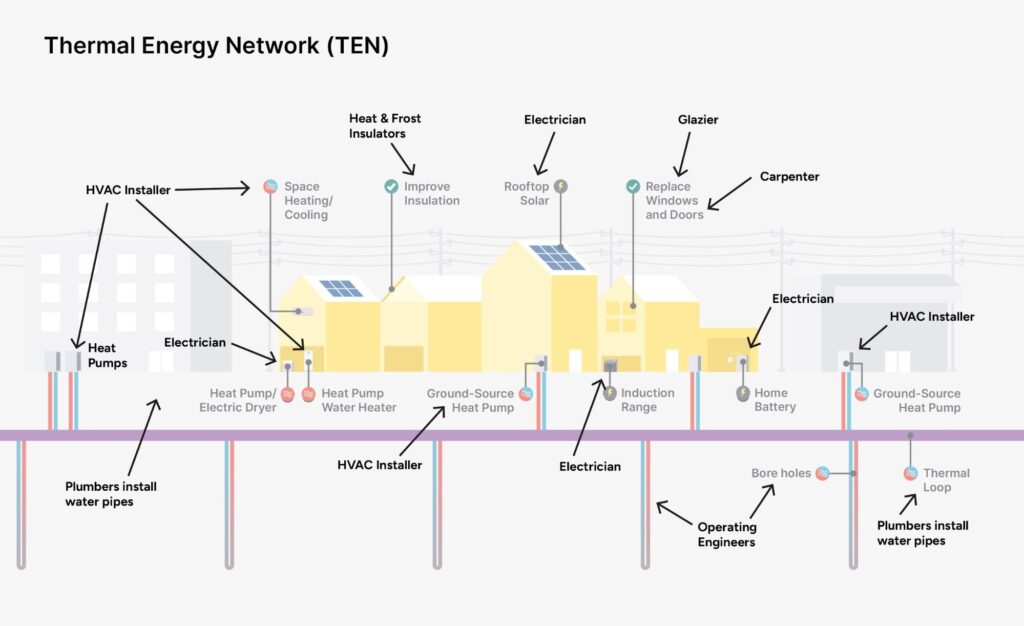
This illustration depicts the types of jobs required to construct and operate a TEN.
-
By their very nature, TENs network people, buildings, and heat. They are a systemic solution that requires communication and coordination. They also provide an opportunity for communities and institutions to collectively imagine their energy future. Numerous community-based organizations across the country are incorporating TENs into their work.
Local governments, especially when partnered with trusted non-governmental organizations, are crucial to identifying opportunities for TENs and GENs and organizing their communities. Here are a few examples:
- In Massachusetts, HEET awarded grants of up to $50,000 to municipalities that expressed interest in conducting geothermal network feasibility studies, and ensured that nearly 50% of the funding went to environmental justice communities.
- In Vermont, advocates, local leaders, energy commission members, and regional planners created a step-by-step “how-to” resource to help municipal leaders bring non-emitting thermal energy infrastructure to their towns, with or without utility involvement.
Investor-owned utility TENs pilots must engage communities early and often to address concerns, hear ideas, establish consent, and ensure that pilots are matched to the most suitable, equitable sites.
